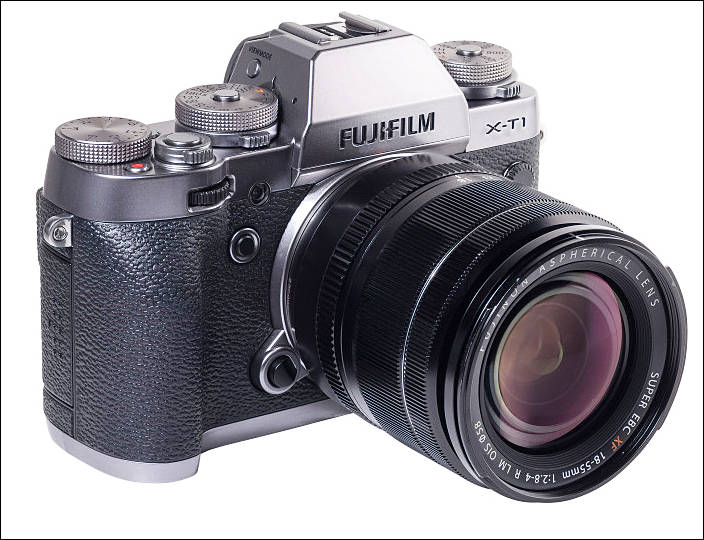
-

This camera is also the first in my opinion that truly gives us a glimpse of the future with the capabilities of its electronic viewfinder (EVF). Their implementation of the EVF is simply brilliant. It is bright, sharp, big and allows all shooting data to be displayed. When manual focusing, you have the smaller magnified window that appears. Using that in combination with focus peaking, makes getting sharp manually focused images a breeze. And, when you rotate the camera to vertical, the data in the viewfinder changes to vertical orientation too. There's a lot to like about EVFs.
http://www.luminous-landscape.com/essays/cameras/living_with_the_fuji_x_t1.shtml

 various10.jpg648 x 506 - 61K
various10.jpg648 x 506 - 61K -
New firmware is available V3.0
http://www.fujifilm.com/support/digital_cameras/software/firmware/x/xt1/index.html
-

The Fujifilm X-T1 Graphite Silver can record full HD 1080p movies at 60/30fps with stereo sound and a high bitrate (36Mbps), with the option for turning this mode on curiously buried at the bottom of the Drive menu, although at least Fujifilm have finally added a one-touch record button. It's fair to say that the X-T1 Graphite Silver's movie mode isn't overly advanced. You can set the aperture and shutter speed before recording begins, but not during, and you can also set the Film Simulation mode, so black and white footage is possible, and the exposure compensation.
http://www.photographyblog.com/reviews/fujifilm_x_t1_graphite_silver_review/

 premium4.jpg800 x 514 - 67K
premium4.jpg800 x 514 - 67K -

 came-8000-8.jpg800 x 647 - 70K
came-8000-8.jpg800 x 647 - 70K -
Firmware v3.0 will be available for download on December 18 .
- AF (Auto Focus) Area direct selection – Users can select the focus area with the 4-way controller, without pressing the Fn Button.
- Function replacement for the AE-L/AF-L buttons – The currently locked AE-L/AF-L button function will now be interchangeable, depending on the user’s preference.
- Focus Area size variability during MF (Manual Focus) – Users will be able to change the focus area in Manual mode during One Push AF with the AF-L button.
- Macro Mode direct selection – Users will be able to directly turn ON or OFF the Macro function in Auto Focus mode to expand the distance measurement range to the short-distance range. This will be possible without accessing the pop-up menu screen.
- Q Menu customization – The update will render the items and layout of the Q Menu, used for quick access of frequently-used items, changeable to the user’s preference.
- Video frame rate selection – In addition to the existing 60fps and 30fps selections, 50fps and 25fps, as well as a 24fps selection will become available to users. 50fps and 25fps allow video editing in the PAL region, such as Europe and elsewhere, without converting the frame rate. The 24fps will offer movie-like video capture and play back.
- Video manual shooting – Users will be able to select ISO sensitivity prior to shooting videos, as well as adjusting the aperture and shutter speed during video shooting.
- Phase Detection AF support for One Push AF – With One Push AF, operated by pressing the AF-L button during manual focusing, the update will enable Phase Detection AF with quicker focusing speeds.
- Metering area focus area interlocking – The update will enable users to interlock the AF area position with the metering area when spot metering is selected.
- Expansion of the Program Shift setting area – The update will enable the current Program Shift, in which the low-speed side is 1/4 second, to be shifted to a maximum of 4 seconds.
- Electronic Shutter – Adds electronic shutter function to original X-T1 Black bodies with a maximum shutter speed of 1/32000 second.
- “Classic Chrome” Film Simulation – Film simulation that delivers muted tones and deep color reproduction.
- Support for INSTAX Share Printer – Photos can be sent directly to the INSTAX Share Printer for instant prints.
- Lock Function – Users can lock the camera to prevent unexpected dial and button operations.
- AF+MF Setting – Users can half press the shutter to autofocus, and then make fine adjustments using the manual focus ring.
- Three Custom White Balance options – Expands number of white balance users can store.
- Expanded EVF/LCD display types in Manual Exposure Mode – Users can now customize the way the image is displayed on the EVF or LCD.
- LCD Brightness and EVF/LCD Adjustment Control – Users can customize display brightness based on environment.
- Flash Compensation in Fn Button Setting – Users can now add Flash Compensation to any of the six custom function buttons.
-
Thanks for replying Vitaliy, I had a Gh1 for the last 4 years and loved the hack
The post above the bit about downsampling, does that sound like a logical assumption or am I tilting at windmills. I just have the feeling that the X-trans could be a great video sensor because of the lack of aliasing but its being let down by poor codec implementation.
I know you should never buy a camera in the hope of firmware being added or a hack being forthcoming and I won't, but I would be slightly gutted if I went with the X-E2 as its cheaper and then the X-t1 turns out to become a video monster :)
G
-
PPS they have also implemented UHS-ii for sd cards which will help with FPS, but also makes me wander if they have plans for higher bitrate video?
No one knows this except them :-)
-
PPS they have also implemented UHS-ii for sd cards which will help with FPS, but also makes me wander if they have plans for higher bitrate video?
-
In light of my above post, this raises an intersting question. In my opinion the main issue with the Fuji X-T1 for video is the lack of manual control of shutter speed and 24p/25p this is now resolved by the above. Great.
The other massive issue is that the footage is prone to aliasing. Thing is I think they could fix this in the firmware as well. But I wanted to confirm my thinking with you guys as you are far more switched on that me.
Apparently the beauty of the X-trans sensor is that because of its RGB layout you don't require an anti alias filter because the sensor naturally does not have and Aliasing...........
So why aliasing in video? my conclusion (and if flawed please call it out) is that the aliasing is from downsampling the sensor, either because they have to because it too big i.e 16MPeg APS-C or because the H.264 codec they are using is too small, or probably a combination of both.
So if they a) Implemented 1-1 sampling of the sensor (possibly introducing a crop, but this would probably still be better than a 4/3s crop b) Implemented a better codec AVCHD (not sure if they can or if its cost effective as its propriety to Sony/Panasonic) or I guess something else.
Would that get rid of or diminish aliasing.
The final thing thinking about it that they would need to do is implement a way of 16/9 framing so that you could actually compose properly, there are workarounds, but it would be great if you could set up one of the custom buttons to switch to this view.
So does any of this make sense, as if it does I might put it in as a feature request to Fuji as them seem quite open to user feedback.
Appreciate everyones patience if I am barking up the wrong tree.
-
Hi, I am sure that everyone is aware of the latest firmware coming in Dec, and that it has 2 interesting upgrades to video performance.
"Video frame rate selection - In addition to the existing 60fps and 30fps selections, 50fps and 25fps, as well as a 24fps selection will become available to users. 50fps and 25fps allow video editing in the PAL region, such as Europe and elsewhere, without converting the frame rate. The 24fps will offer movie-like video capture and play back"
"Video manual shooting – Users will be able to select ISO sensitivity prior to shooting videos, as well as adjusting the aperture and shutter speed during video shooting."
-

Video sample - http://www.ixbt.com/digimage/fuji/x-t1/video/vid-2.mov

 gopro6.jpg800 x 546 - 65K
gopro6.jpg800 x 546 - 65K -

 sales8.jpg800 x 436 - 65K
sales8.jpg800 x 436 - 65K -

While the X-T1 is a powerful mirrorless camera with an intriguing design, it's difficult to give it an unquestioned recommendation because of that high starting price. It has enough quirks in its design that some photographers may not want to invest the time required to learn how to take full advantage of this model. But, it also has enough great features that if you love the retro design, you may be willing to purchase the Fujifilm X-T1 without concern over the price.
http://www.steves-digicams.com/camera-reviews/fujifilm/x-t1/fujifilm-x-t1-review.html

 gh4_39.jpg800 x 437 - 101K
gh4_39.jpg800 x 437 - 101K -

 cons28.jpg800 x 532 - 89K
cons28.jpg800 x 532 - 89K -

IQ of the X-T1 (paired with the XF10-24mm and XF55-200mm for the most part) has exceeded my expectations. Whilst it may have fewer megapixels than the 5D3, it seems to me to have better dynamic range and the shadows are less prone to noise. There are differences in colour and tonal rendition but neither ‘wins’, they’re just different and it’s down to personal choice.

 sample10.jpg728 x 485 - 69K
sample10.jpg728 x 485 - 69K -
X-T1 Firmware Update Ver.1.10
- Addition of compatibility with "XF18-135mmF3.5-5.6 R LM OIS WR" To ensure that autofocus performs as expected, upgrade the firmware for the camera.
- Improvement of "Exposure compensation/exposure indicator" in EVF Values are added to the scales of the indicator for better visibility.
- Improvement of Movie-record button operability To avoid an accidental movie shooting, the delayed time will become longer between the moment you press the button and a movie shooting starts or ends.
- The phenomenon is fixed that images are not recorded with the set interval when "INTERVAL" in "INTERVAL TIMER SHOOTING" is set to 5 sec or less. In this case, the setting of "IMAGE DISP." in "SCREEN SET-UP" will change to "OFF" automatically.
http://www.fujifilm.com/support/digital_cameras/software/firmware/x/xt1/index.html
-

 sales71.jpg798 x 532 - 145K
sales71.jpg798 x 532 - 145K -
The new camera earned an Extremely High rating in image quality from ISO 100 through ISO 400. As with other Fujifilm X-series cameras, the X-T1 will let you record only JPEGs when set to the extremes of its sensitivity range, in this case ISO 100, 12,800, 25,600, and 51,200.
http://www.popphoto.com/gear/2014/05/camera-test-fujifilm-x-t1
-

 sales85.jpg532 x 799 - 62K
sales85.jpg532 x 799 - 62K
Howdy, Stranger!
It looks like you're new here. If you want to get involved, click one of these buttons!
Categories
- Topics List23,991
- Blog5,725
- General and News1,354
- Hacks and Patches1,153
- ↳ Top Settings33
- ↳ Beginners256
- ↳ Archives402
- ↳ Hacks News and Development56
- Cameras2,367
- ↳ Panasonic995
- ↳ Canon118
- ↳ Sony156
- ↳ Nikon96
- ↳ Pentax and Samsung70
- ↳ Olympus and Fujifilm101
- ↳ Compacts and Camcorders300
- ↳ Smartphones for video97
- ↳ Pro Video Cameras191
- ↳ BlackMagic and other raw cameras116
- Skill1,960
- ↳ Business and distribution66
- ↳ Preparation, scripts and legal38
- ↳ Art149
- ↳ Import, Convert, Exporting291
- ↳ Editors191
- ↳ Effects and stunts115
- ↳ Color grading197
- ↳ Sound and Music280
- ↳ Lighting96
- ↳ Software and storage tips266
- Gear5,420
- ↳ Filters, Adapters, Matte boxes344
- ↳ Lenses1,582
- ↳ Follow focus and gears93
- ↳ Sound499
- ↳ Lighting gear314
- ↳ Camera movement230
- ↳ Gimbals and copters302
- ↳ Rigs and related stuff273
- ↳ Power solutions83
- ↳ Monitors and viewfinders340
- ↳ Tripods and fluid heads139
- ↳ Storage286
- ↳ Computers and studio gear560
- ↳ VR and 3D248
- Showcase1,859
- Marketplace2,834
- Offtopic1,319














